Yokota Air Base
| Yokota Air Base 横田飛行場 Yokota Hikōjō  | |
|---|---|
| Part of Pacific Air Forces (PACAF) | |
| Located near: Fussa, Tokyo, Japan | |
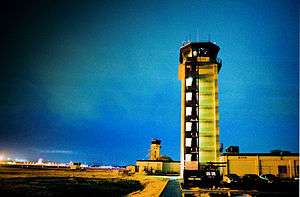 The air traffic control tower at Yokota Air Base | |
| Coordinates | 35°44′55″N 139°20′55″E / 35.74861°N 139.34861°E |
| Site information | |
| Controlled by |
|
| Site history | |
| Built | 1940 |
| In use | 1940-Present |
| Garrison information | |
| Garrison |
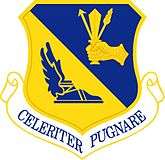 374th Airlift Wing (USAF) |
| Yokota Air Base | |||||||||||
|---|---|---|---|---|---|---|---|---|---|---|---|
| Summary | |||||||||||
| Elevation AMSL | 463 ft / 141 m | ||||||||||
| Coordinates | 35°44′55″N 139°20′55″E / 35.74861°N 139.34861°ECoordinates: 35°44′55″N 139°20′55″E / 35.74861°N 139.34861°E | ||||||||||
| Website | www.yokota.af.mil | ||||||||||
| Map | |||||||||||
 RJTY Location of Yokota Air Base | |||||||||||
| Runways | |||||||||||
| |||||||||||
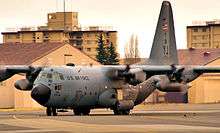
Yokota Air Base (横田飛行場 Yokota Hikōjō), (IATA: OKO, ICAO: RJTY) is a United States Air Force (USAF) base in the city of Fussa, one of 26 cities in the Tama Area, or Western Tokyo.
The base houses 14,000 personnel. The base occupies a total area of 7.07 km2 (2.73 sq mi) and has a 3,353 m × 61 m (11,001 ft × 200 ft) runway. Among its facilities are the broadcast center for the American Forces Network Tokyo radio service and a detachment of Pacific Air Forces' Band of the Pacific and the headquarters of United States Forces Japan.
Units
The host unit at Yokota is the 374th Airlift Wing and is currently used for airlift missions throughout East Asia. The 374th includes four groups: operations, mission support, maintenance and medical. Each group manages a various number of squadrons in order to carry out the wing's mission.
- 374th Operations Group (Tail Code: YJ)
The 374th Operations Group maintains a forward presence by providing rapid responsive movement of personnel, equipment and operational support in the Asia-Pacific region. The group consists of:- 374th Operations Support Squadron
- 36th Airlift Squadron (C-130J Super Hercules)
- 459th Airlift Squadron (UH-1N Iroquois (Huey), (C-12J Huron)[2]
It is not uncommon to see a KC-135 Stratotanker, C-135 Stratolifter, C-5 Galaxy, KC-10 Extender, KC-767, KC-46 Pegasus, C-130, DC-8, C-17, L-100, Boeing 747, civilian charter airline aircraft (Omni Air International, Air Transport International etc.) and cargo (Atlas Air, Kalitta Air etc.) on military charters on the Transient Aircraft ramp.
- 374th Maintenance Group
The 374th Maintenance Group maintains C-130J, C-12 and UH-1N aircraft supporting intratheater airlift and distinguished visitor transport for Pacific Air Forces. - 374th Mission Support Group
The 374th Mission Support Group is responsible to the 374th Airlift Wing Commander for command, control and direction of support activities to 374 AW and 32 tenant units to include HQ US Forces Japan and Fifth Air Force. - 374th Medical Group
The 374th Medical Group, ensures medical readiness of 374 AW, 5 AF, and US Forces Japan personnel. They also maintain 64 War Reserve Materiel projects, including the USAF's largest Patient Movement Item inventory. - Associate/Tenant Units
- U.S. Forces, Japan (USFJ) -- a nonoperational, politico-military unit that serves as the USPACOM front for US-Japanese military discussions.
- Fifth Air Force (5 AF) -- the air component to USFJ.
- 730th Air Mobility Squadron
- Air Force Band of the Pacific-Asia
- Stars & Stripes
- American Forces Network
- U.S. Coast Guard (USCG) Activities Far East (FEACT) (inspection of ships bound for U.S. ports for port control and safety reasons).
- Yokota Cadet Squadron, Civil Air Patrol
AMC passenger terminal

The newly renovated Air Mobility Command (AMC) Passenger Terminal is on the main part of the base next to the flightline. It is a 5 to 7-minute walk from the Kanto Lodge (see below) and offers Space-Available flights to various destinations in PACAF such as Alaska, Guam, Hawaii, Korea, Okinawa, Singapore, as well as the Continental United States.
History
Tama Airfield
The facility which houses Yokota Air Base was originally constructed by the Imperial Japanese Army (IJA) in 1940 as Tama Airfield, and used as a flight test center. During World War II Yokota became the center of Japanese Army Air Forces flight test activities and the base was the site of the first meeting between Japanese and Italian wartime allies.
Tama was first identified by United States Army Air Forces (USAAF) in November 1944 by a 3d Reconnaissance Squadron F-13 Superfortress photo-reconnaissance aircraft, flying from Tinian in the Mariana Islands. It was identified as being associated with a nearby Musashino-Nakajima aircraft manufacturing plant. Along with the Showa Air Base to the northwest, and Tachikawa Air Base to the east, it was compared to the aircraft development complex of the USAAF Wright-Patterson Field in Ohio. According to the USAAF intelligence at the time, the three bases conducted all IJA flight testing. In the spring of 1945, XXI Bomber Command attacked the base eight times along with the aircraft manufacturing plant, but each time heavy clouds forced the bombers to attack secondary targets. The Nakajima plant was finally attacked in April 1945, but the Tama airfield never was bombed.
Postwar years
With the Surrender of Japan on 2 September 1945, a detachment of the United States Army 1st Cavalry Division arrived at the base on 4 September. The airfield's buildings were largely intact, and some 280 of the IJA's most modern aircraft were discovered in hangars.
The 1st Cavalry named the facility Fussa Army Airfield, then at the end of September renamed it Yokota Army Airfield (the name appeared on a 1944 US map, taken from a village which has since been incorporated in neighboring Musashimurayama.)
The name was to have been changed to Wilkins Army Air Base (WAAB) after Medal of Honor winner Raymond "Ray" Wilkins, but orders for this never arrived and it remained under the name Yokota until the USAAF became the USAF in 1947, at which point it became Yokota Air Base.[3] Some metal manhole covers stamped "WAAB" remain in use around the base as of 2017.
The initial USAAF use for the base was for airlift operations when the 2d Combat Cargo Group arrived with four C-47 Skytrain squadrons. When the old runway deteriorated under heavy usage, the runway was repaired and Yokota supported operations of the A-26 Invader-equipped 3d Bombardment Group by August 1946. Additional construction during the 1940s and 1950s was completed and the base reached its current size around 1960.
On the occasion of extension, the course of Hachiko Line and national highway Route 16 was changed, and Itsukaichi highway was divided.
During the initial postwar occupation years, Yokota hosted the following known USAAF/USAF units:
- 20th Combat Mapping Group (October 1945 - April 1946) (F-7 Liberator)
- 8th Reconnaissance Group (June 1946 - October 1947) (F-7)
- 71st Reconnaissance Group (February 1947 - April 1949) (RB-17, RB-29, RF-51, RF-61 and RF-80)
These units performed photographic reconnaissance and mapping of Japan and South Korea.
- 6th Night Fighter Squadron (1946–47) (P-61A/B)
Inactivated and personnel, mission and equipment transferred to 339th Fighter Squadron (347th Fighter Group) with F-82F/G Twin Mustangs at Nagoya Air Base. - 82nd Photo Reconnaissance Squadron (1947–48) (FP-80)
- 3d Emergency Rescue Squadron (July 1947 - April 1950) (SB-17G)
Flew modified B-17G bombers equipped under their bellies with a 27-foot boat (termed the A-1) that could be dropped by parachute and which contained enough food, water, and clothing for twelve survivors to last for about twenty days in the ocean.
Korean War
During the Korean War, Yokota was used for combat missions over North and South Korea. Known units based there were:
- Fighter units
- 27th Fighter-Escort Wing (November - December 1950)[4]
Flew F-84E Thunderjets on armed reconnaissance, interdiction, fighter escort, and close air support missions. - 35th Fighter-Interceptor Wing (April - August 1950)[4]:61
Flew F-80Cs on air defense missions. - 339th Fighter Squadron (April - August 1950)
Attached to 35th Fighter-Interceptor Wing and flew F-82F/G Twin Mustang missions over South Korea during the first few months of hostilities.
- 27th Fighter-Escort Wing (November - December 1950)[4]
- Bombardment units
- 92d Bombardment Group (325th, 326th and 327th Bombardment Squadrons) (July - October 1950)
Deployed squadrons from Spokane Army Airfield, Washington. Flew B-29 Bombing missions over North Korea. - 98th Bombardment Wing (343d, 344th and 345th Bomb Squadrons) (August 1950 - July 1954)<rafe name=Ravenstein/>:139
Group, then Wing deployed from Spokane Army Airfield. Flew B-29 Bombing missions over North Korea. Two days after arriving at Yokota, the squadrons a bomb mission against marshalling yards at Pyongyang, North Korea. The 98th BG engaged primarily in interdiction of enemy communications centers but also supported UN ground forces. Interdiction targets included marshalling yards, oil centers, rail facilities, bridges, roads, troop concentrations, airfields, and military installations.
- 92d Bombardment Group (325th, 326th and 327th Bombardment Squadrons) (July - October 1950)
- Reconnaissance units
- 31st Strategic Reconnaissance Squadron Photographic (July–August 1950)
Flew combat missions to provide FEAF Bomber Command with target and bomb-damage assessment photography. - 91st Strategic Reconnaissance Squadron, Medium, Photographic (December 1950 - December 1954)
Assigned to 407th Strategic Fighter Wing (1953–54)[4]:221
Absorbed the personnel and resources of the 31st Strategic Reconnaissance Squadron in Japan. Using RB-29, RB-45, RB-50 and RB-36 aircraft, it performed target and bomb-damage assessment photo and visual reconnaissance for FEAF Bomber Command, flew other special photographic missions, and conducted electronic "ferret" reconnaissance to determine frequency, location, and other characteristics of enemy ground radar. The squadron also performed shipping surveillance over the Sea of Japan near the Siberian coast and leaflet drops over North Korea. Beginning in late 1952, rotating aircrews of the Philippine-based 581st Air Resupply and Communications Wing augmented the 91st SRS in flying leaflet missions. - 512th Bombardment Squadron (January - August 1950)
Operated the B/RB/WB-29 aircraft and flew weather reconnaissance missions. - 56th Weather Reconnaissance Squadron (September 1951 - July 1972)
Replaced the 512th Bomb Squadron in their weather reconnaissance mission. They operated WB-29, WB-50, WC-135B and RB-57 aircraft used to sample airborne nuclear debris as well as weather patterns in the Pacific.
- 31st Strategic Reconnaissance Squadron Photographic (July–August 1950)
Cold War
With the Korean War ending in July 1953, Yokota Air Base returned to a peacetime Cold War status. Two major wings were stationed at the base during the 1950s, the 67th Reconnaissance Wing (1956–60) flying RF-80s, RF-84s and lastly RF-101s.[4]:106 The 35th Fighter-Interceptor Wing (1954–57) flew F-86 Sabres from the base.[4]:106 A Tactical Air Command (TAC) air refueling unit, the 421st Air Refueling Squadron flew KB-29s,and later KB-50Js from Yokota from 1953-65. All of these units were under the command of the 41st Air Division.
The 35th TFW was reassigned in 1957 and the 67th TRW in 1960. Defense budget restrictions in the late 1950s caused several PACAF wings based in Japan to be reassigned or inactivated. These tactical fighter units were replaced by the B-57 equipped 3rd Bombardment Wing where it trained in bombardment, reconnaissance and aerial refueling operations. The Air Defense Command 40th Fighter-Interceptor Squadron (December 1961 - May 1962) equipped with the F-102 Delta Dagger performing an air defense mission.
The 6102d Air Base Wing assumed host unit status for the base, being replaced by the 441st Combat Support Group in 1964.
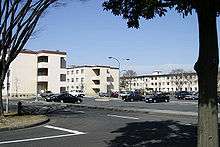
The Vietnam War resulted in an increased combat and airlift aircraft presence at the base. Yokota was used for ferrying B-52 Stratofortresses to Southeast Asia along with being a base for US-based deployed F-105 Thunderchief 35th, 36th and 80th Tactical Fighter Squadrons. The 610th Military Airlift Support Squadron (1966–78) was created by Military Airlift Command (MAC) to service the large increase in transiting airlift. The 65th Military Airlift Support Group (1969–71) was a headquarters organization for MAC airlift support squadrons in the Pacific and Far East.
The F-105 squadrons deployed frequently to USAF-operated bases in Thailand to fly combat missions over North and South Vietnam, and to South Korea for alert missions. Initially the fighter squadrons were under the command of the 41st Air Division, shortly after reassigned to the 6441st Tactical Fighter Wing, activated in April 1965 to control the F-105 squadrons after their parent organization, the 8th Tactical Fighter Wing, relocated to George Air Force Base, California, to become an F-4 Phantom II unit. With the reassignment of the 347th Fighter Wing to Yokota in 1968, the 347th assumed responsibility for all tactical fighters until its reassignment to Kunsan Air Base, South Korea, in March 1971.[4]:183
In 1971, all combat squadrons were transferred to Kadena and Misawa Air Base and Yokota became a non-flying station hosted by the 475th Air Base Wing.[4]:264 The 475th had no numbered flying squadrons, but operated a few T-39 Saberliners and UH-1 helicopters, along with supporting transient MAC cargo and passenger aircraft. Assigned flying squadrons returned to Yokota in 1975 when the 345th Tactical Airlift Squadron was assigned with its C-130Es.
Headquarters, Fifth Air Force was transferred to Yokota on November 11, 1974, being transferred from Fuchū Air Base, Japan.
Post-Cold War
In 2005, the Japanese government announced that the headquarters of the Japan Air Self-Defense Force would be moved to Yokota.
The Tokyo Metropolitan Government has advocated opening Yokota to civilian flights as a method of relieving traffic at Haneda and Narita Airport. Governor Shintaro Ishihara raised the joint-use proposal during the 2003 gubernatorial election, and Governor Naoki Inose made comments in 2013 that suggested joint use as a possible solution to cope with visitor demand during the 2020 Summer Olympics in Tokyo.[5]
In November 2009, the base was attacked by leftist extremists via improvised mortar barrages.[6]
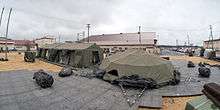
In April 2010 Colonel Frank Eppich, the USAF commander of base, banned screenings of the film The Cove at the base theater. A base spokesman said that The Cove was banned because using a base venue to display the film could be seen as an endorsement of the film. The spokesman added, "We have a lot of issues with Japan...and anything done on an American base would be seen as an approval of that event."[7]
Personnel and aircraft from the base assisted with Operation Tomodachi following and during the March 2011 Tōhoku earthquake and tsunami and Fukushima I nuclear accidents. The base also served as an important hub for airlifted assistance during the disaster recovery efforts. During the crisis, around 600 American family members voluntarily departed the base for locations outside Japan.[8]
James Mattis arrived at the base in February 2017 during his first overseas trip as Secretary of Defense.[9] Donald Trump arrived at the base at the start of his first visit to Asia since becoming US President.[10]
On April 5, 2018 five CV-22 Osprey tiltrotor aircraft deployed to the base. They had originally been scheduled to deploy to Yokota in 2020, but the deployment was brought forward. As the first permanent deployment of the aircraft outside of Okinawa the move sparked local protests.[11][12][13][14][15] The number of aircraft will eventually reach 10.[16]
Lawsuits
Resistance to the air base immediately followed the end of US occupation. Gravel used in the construction of the airfields was taken from the Tama River, lowering the riverbed and affecting the traditional irrigation system (Fuchū-yōsui), which had provided water to local communities since the early Edo period. The base also caused great stress to nearby inhabitants in a number of other ways, such as fuel leaks and spills that contaminated groundwater and well water; foul odors and fires, deafening noise pollution and repeated plane crashes. Although local leaders succeeded in bringing about the return of land that had been taken for a base in Tachikawa, at Yokota the number of departures and landings per year reached 20,000. Pilot training that simulated landing jets on aircraft carriers was also held several times each year, often throughout the night.[17] Because such training, together with the engine testing and daily flights, created a level of noise pollution that local inhabitants found unbearable, numerous lawsuits were filed against the Japanese and U.S. governments, calling for a halt in flights and compensation for damages caused by the noise pollution.[18] At present, a small fraction of the compensation demanded for past damages appears likely to be awarded. “Yokota Airbase Pollution Lawsuit No. 9,” filed on December 12, 2012 and “New Yokota Airbase Pollution Lawsuit No. 2,” filed on March 26, 2013, are currently being disputed.
Major commands to which assigned
- 1st Cavalry Division, United States Army Forces Pacific, (September 1945)
- Pacific Air Command US Army, (September 1945 - January 1947)
- Far East Air Forces (January 1947 - July 1957)
- Pacific Air Forces (July 1957–present)
Base amenities
The 374th Force Support Squadron
The 374th Force Support Squadron is responsible for providing an enhanced quality of life, facilities and programs for 11,000 military, civilian and dependents as well as 150,000 transient personnel per year. The 374th Force Support Squadron provides manpower and personnel support, membership clubs, child development, youth programs, food service, lodging, sports/fitness, recreation/leisure activities, comprehensive readiness program, marketing/publicity, linen exchange, and mortuary operations for Yokota AB.[19]
Friendship Festival
Each year in September, Yokota Air Base opens the gates to the Japanese community for its annual Friendship Festival. For two days, local residents can learn about Yokota Air Base. Food and events are provided for all ages. Roughly 200,000 visitors show up each year, although non-Japanese visitors may be turned away from the gates for security reasons. Prospective attendees who are neither Japanese or American should bring identification and also consult the Third Country National list to see if they require special approval to enter the base.
For those two days, visitors are able to examine many types of aircraft and even tour some of the large cargo planes from inside.
Education
The Department of Defense Education Activity operates schools at Yokota for children of personnel assigned to the base. [20]
- Joan K. Mendel Elementary School (formerly known as Yokota East Elementary School)[21]
- Yokota West Elementary School[22]
- Yokota Middle School:[23] School Dedication Ceremony took place on 13 June 2000. YMS initial year began with only grades 7 and 8, with the upstairs specialty wing housing High School classes until construction modifications to YHS were completed. Class officially began August 2000.
- Yokota High School, The Home of the Yokota Panthers.[24] The school was constructed in 1973. A new "21st century" school started construction in 2015 and is due to finish sometime in 2017 and is to replace the old Yokota High School.[25]
Higher educational opportunities for those in the military and working for the Department of Defense, as well as for family members at Yokota are available through several contracted academic institutions. For example:[26]
- The Asian Division of University of Maryland University College (UMUC)[27]
Tama Hills Recreation Area
The Tama Hills Recreation Area comprises about one-half of the 500-acre Tama Services Division Annex, the other half being the Tama Hills Golf Course.[28][29][30]
In popular culture
The base was the setting of Almost Transparent Blue, a best-selling novel written by Ryu Murakami and published in 1976 as well as the anime Blood the Last Vampire and the short film "Baby Blue" from Genius Party, directed by Shinichiro Watanabe (Cowboy Bebop, Samurai Champloo). Yokota Air Base and its surrounding area were the central location for the 2006 movie Sugar and Spice. It is also the setting of parts of The Yokota Officers Club : A Novel by Sarah Bird. The base is also the birthplace of US Marine Captain, former UFC fighter and Fox Sports analyst Brian Stann. The base was also briefly featured in the 2016 biopic Snowden as one of Edward Snowden's workplaces.
References
![]()
- ↑ AIS Japan
- ↑ "Yokota welcomes is newest member the C-12 Huron". Yokota AB News. 6 July 2007. Retrieved 26 July 2018.
- ↑ "Yokota History Part 2: Occupation Period, 1945-51". Yokota Air Base. Retrieved 16 September 2017.
- 1 2 3 4 5 6 7 Ravenstein, Charles A. (1984). Air Force Combat Wings, Lineage & Honors Histories 1947-1977 (PDF). Office of Air Force History. p. 51. ISBN 0912799129.
- ↑ "Tokyo governor eyes Yokota Air Base for civilian flights during 2020 Olympics". Kyodo News. 17 September 2013. Retrieved 19 December 2013.
- ↑ Japanese police raid operational bases of anti-U.S. military group - Japan - Stripes
- ↑ Harnell, Boyd, "Yokota base bans 'Cove' to be neutral", Japan Times, April 13, 2010, p. 1.
- ↑ Reed, Charlie, "Military wraps up first round of departures from Japan", Stars and Stripes, 25 March 2011, retrieved 28 March 2011.
- ↑ 日本放送協会. "米マティス国防長官が日本に到着 | NHKニュース". NHKニュース (in Japanese). Retrieved 2017-02-03.
- ↑ Hudson, Donald (November 5, 2017). "Trump visits Yokota". yokota.af.mil. Retrieved June 18, 2018.
- ↑ "CV-22 Osprey set to deploy at Yokota Air Base also being used for night training in Okinawa, has a higher accident rate than the MV-22". Ryukyu Shimpo. March 29, 2018. Retrieved June 18, 2018.
- ↑ "U.S. military announces early deployment of CV-22 Ospreys to Japan's Yokota Air Base". Japan Times. April 3, 2018. Retrieved June 18, 2018.
- ↑ "Local residents protest Osprey deployment at US Yokota base". Mainichi Shimbun. April 6, 2018. Retrieved June 18, 2018.
- ↑ "U.S. Air Force CV-22 Osprey aircraft to arrive at Yokota AB". United States Forces Japan. April 3, 2018. Retrieved June 18, 2018.
- ↑ Yoshizawa, Hidemasa (April 5, 2018). "5 Ospreys fly to Yokota Air Base amid protests from residents". Asahi Shimbun. Retrieved June 18, 2018.
- ↑ Robson, Seth (April 3, 2018). "Ospreys to arrive at Yokota this week, 2 years ahead of schedule". Stars and Stripes. Retrieved June 18, 2018.
- ↑ 横田基地の概要
- ↑
- ↑ www.YokotaSupport.com
- ↑ Department of Defense Education
- ↑ Joan K. Mendel Elementary School
- ↑ Yokota West Elementary School
- ↑ Yokota Middle School
- ↑ Yokota High School
- ↑
- ↑ University of Maryland: Asia Division
- ↑ UMUC Asia | Quality academic programs for U.S. military communities
- ↑
- ↑ Tama Hills Arsenal « Punynari's Island Adventures
- ↑ "Archived copy". Archived from the original on 15 June 2013. Retrieved 15 June 2013.
Bibliography
- Fletcher, Harry R. (1989) Air Force Bases Volume II, Active Air Force Bases outside the United States of America on 17 September 1982. Maxwell AFB, Alabama: Office of Air Force History. ISBN 0-912799-53-6
- Maurer, Maurer (1983). Air Force Combat Units Of World War II. Maxwell AFB, Alabama: Office of Air Force History. ISBN 0-89201-092-4.
- Ravenstein, Charles A. (1984). Air Force Combat Wings Lineage and Honors Histories 1947-1977. Maxwell AFB, Alabama: Office of Air Force History. ISBN 0-912799-12-9.
- Rogers, Brian (2005). United States Air Force Unit Designations Since 1978. Hinkley, England: Midland Publications. ISBN 1-85780-197-0.
External links
| Wikimedia Commons has media related to Yokota Air Base. |